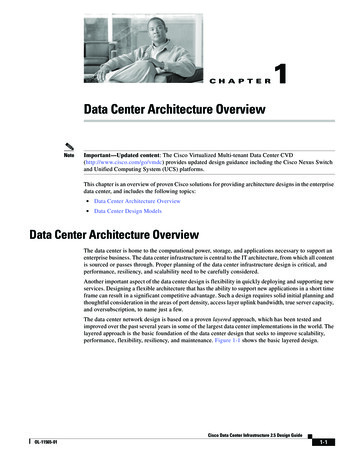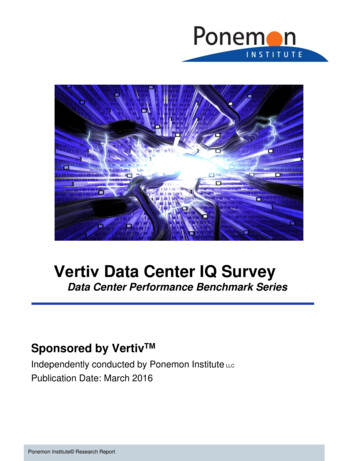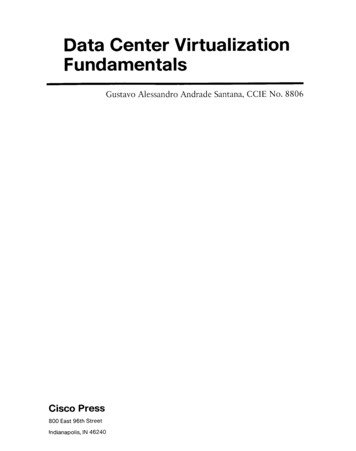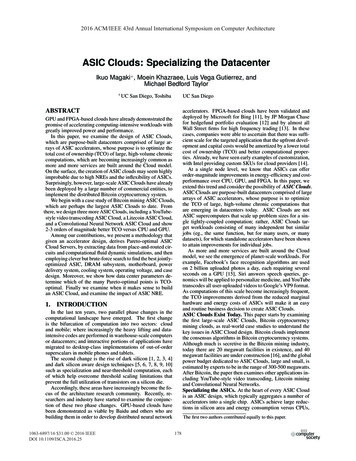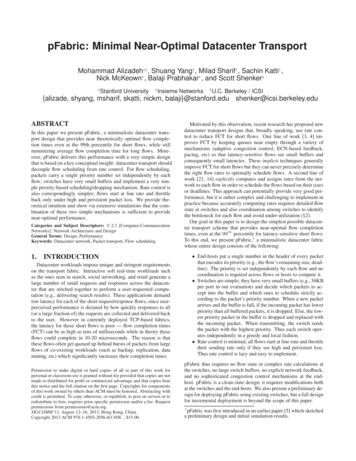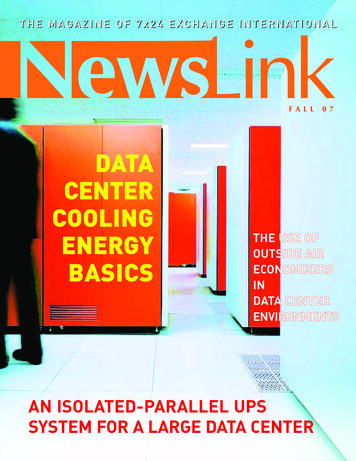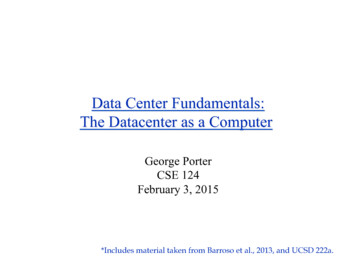
Transcription
Data Center Fundamentals:The Datacenter as a ComputerGeorge PorterCSE 124February 3, 2015*Includes material taken from Barroso et al., 2013, and UCSD 222a.
Data Center Costs! James Hamilton published basic 2008 breakdown Servers: 45% CPU, memory, disk Infrastructure: 25% UPS, cooling, power distribution Power draw: 15% Electrical utility costs Network: 15% Switches, links, transit2
Data center power usage
Data center power efficiency What does power efficiency mean? How could you measure power efficiency? For your own home For a single computer For a data center Can you directly compare Facebook and Google? Netflix.com and Hulu.com?
Quantifying energy-efficiency: PUE PUE Power Usage Effectiveness Simply compares Power used for computing Total power usedPUE (Facility Power) / (Computing Equipment power) Historically cooling was a huge source of power E.g., 1 watt of computing meant 1 Watt of cooling!
Google’s “Chiller-less” Data Center BelgiumMost of the year itis cool enough tonot need coolingWhat about on hotdays? Shed load to otherdata centers!
What about “power saving” features onmodern computers?
Cluster Computing and Map/ReduceGeorge PorterCSE 124February 5, 2015
Credits Some material taken in part from the Yahoo HadoopTutorial More info at: html (Used with permission via a Creative Commons Attribution3.0 Unported License)
Announcements Read the Dean and Ghemawat paper linked off the website to learn about today’s topicMidterm 1 is Tuesday In class Closed book; you may bring a study sheet (front and back),and will turn that sheet in with your exam Will cover material up to Jan 27No data center material, no Brewer, no MapReduce
Datacenter-scale Internet Applications
An explosion of data New types of applications are hosted online Key feature is large data sizes Application-specific: Maps, searches, posts, messages,restaurant reviews Networks: friends list, contacts list, p2p apps Web analytics: clickstream (ads), logs, web crawl data, tracedata, . Processing needs On-line: searches, IMs, ad-insertion Off-line/batch: compute friends network, identify slowmachines, recommend movies/books, understand how userstraverse your website
Size of “data-intensive” has grown198519901995200020052010201513
Size of “data-intensive” has grown1985100MB1990199520001 TB200520102015100 TB1,000,000x increase14
Map/Reduce motivation Prior experience: Lots of “one off” programs to process data Each one handles data movement, machine failure, networkbandwidth management, . Scheduling, coordinating across the cluster really hard 10s of thousands of these programs! Idea: Can we identify the common data operations and providethose as a central service? Solve data movement, fault tolerance, etc. once, not eachtime
Functional Programming Example LISP, Haskell, . (map f list): apply f to each element of ‘list’ (map square [1 2 3 4]) à (1 4 9 16) (reduce g list): apply g pairwise with elements of ‘list’ (reduce [1 4 9 16]) à 30 No side effects Order of execution doesn’t matter Question: How would we parallelize map? How would we parallelize reduce?
map() examplesmap() “ 1” (2, 4, 5, 8) à (3, 5, 6, 9) iseven() (2, 4, 5, 8) à (true, true, false, true) tokenize() (“The quick brown fox”) à (“The”, “quick”, “brown”, “fox”)
reduce() Examplesreduce() “ ” (2, 4, 5, 8) - 8 (2, 4, 5, 8) à 19 countTrue() (true, true, false, true) à 3max() min() (2, 4, 5, 8) - 2
MapReduce Programming ModelInput: Set key-value pairs 1.Apply map() to each pair2.Group by key; sort each group3.Apply reduce() to each sorted groupMap tasksMMMMMMMMMMRRRRRRRRRRReduce tasks19
Map/reduceR1R2R3 Each color represents a separate key. All values with same key processed by thesame reduce function
Map/Reduce example: wordcount s “UCSD Computer Science is a top Computer Scienceprogram”wordcount(s) desired result: UCSD: 1 Computer: 2 Science: 2 is: 1 a: 1 top: 1 program: 1
Map/Reduce example: wordcount map s “UCSD Computer Science is a top Computer Scienceprogram”map(s, const(1)):result: [ “UCSD”, 1 , “Computer”, 1 , “Science”, 1 , “is”, 1 , “a”, 1 , “top”, 1 , “Computer”, 1 , “Science”, 1 , “program”, 1 ]Note repeated values Why?
Map/Reduce example: wordcount shuffle/sort Hadoop runtime will gather together key-value pairs withthe same key and append the values into a single list:input: [ “UCSD”, 1 , “Computer”, 1 , “Science”, 1 , “is”, 1 , “a”, 1 , “top”, 1 , “Computer”, 1 , “Science”, 1 , “program”, 1 ]output: [ “UCSD”, [1] , “Computer”, [1, 1] , “Science”, [1,1] , “is”, [1] , “a”, [1] , “top”, [1] , “program”, [1] ]
Map/Reduce example: wordcount reduce Reduce function (i.e., ) applied to each key (and valuelist)input: [ “UCSD”, [1] , “Computer”, [1, 1] , “Science”, [1,1] , “is”, [1] , “a”, [1] , “top”, [1] , “program”, [1] ]output: UCSD: 1Computer: 2Science: 2is: 1a: 1top: 1program: 1
Open-source software project Implements Map/Reduce and the Google File System Originally led by Yahoo Where did the name ‘Hadoop’ come from? Based on two Google papers: The Google File System, Sanjay Ghemawat, HowardGobioff, and Shun-Tak Leung, SOSP, 2003. MapReduce: Simplified Data Processing on Large Clusters,Jeffrey Dean and Sanjay Ghemawat, OSDI, 2004.
What is Hadoop? .a programming model Way of specifying data processing operations Modeled after functional languages like Haskell or LISP .a distributed system implementing that model Software running in the data center Responsible for executing your programDespite underlying failuresHandles jobs from many users
Data center realities Computing 2-CPU, 10s of GB of memory, 4 to 8 TB drives Networking 2 or 3 level hierarchy 1 or 10 Gb/s from server to top-of-rack switch Keep the server cost low Reduce the movement of data Move computation to the data (Cross-data center bandwidth can be quite limited) Failures are the default case They’re really common!
Execution model Distribute processing of data across 100-1000s ofmachinesReuse the infrastructure by providing differentimplementations of map() and reduce() Data oriented—push computation near the data Aligned with the realities of data centers Easy to parallelize
Loading data into HDFS
Hadoop Architecture HDFS NameNode holdsmetadata Files broken up andspread across DataNodes Map/Reduce JobTracker schedules andmanages jobs TaskTracker executesindividual map() andreduce() tasks
Responsibility for metadata and data
Map/Reduce runtime
Data Center Fundamentals: The Datacenter as a Computer George Porter CSE 124 February 3, 2015 *Includes


